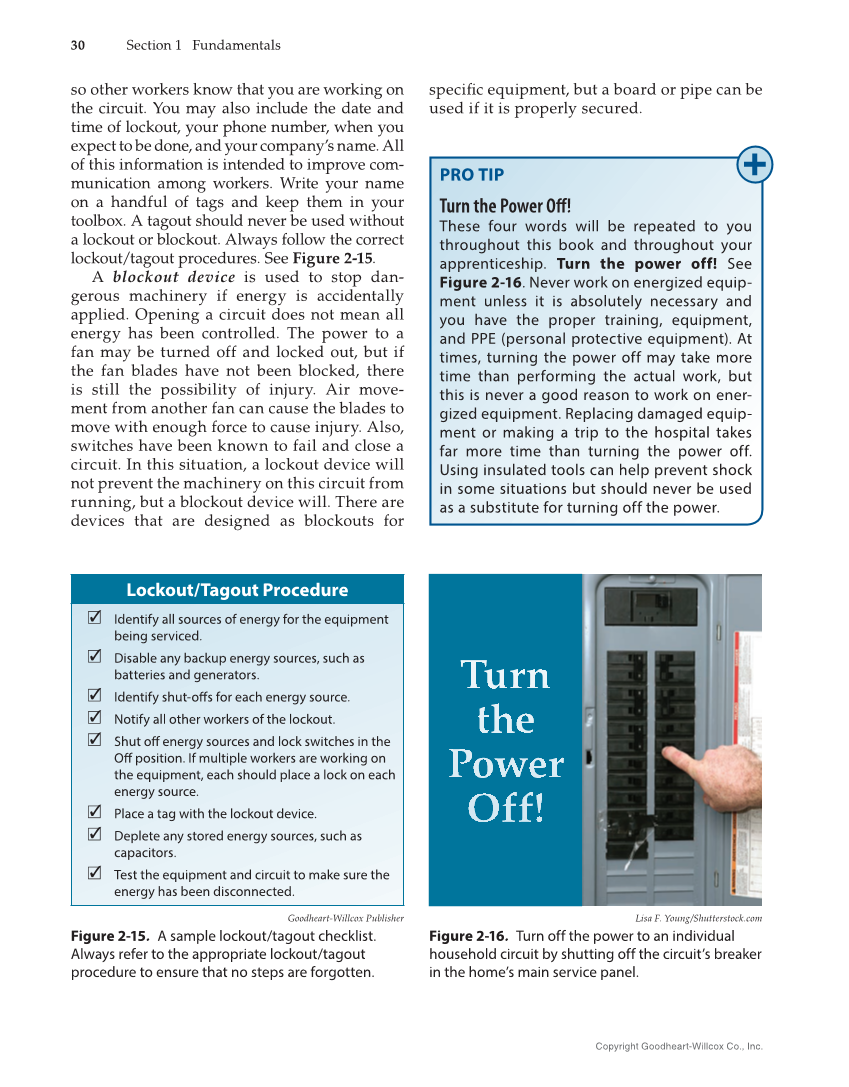30 Section 1 Fundamentals Copyright Goodheart-Willcox Co., Inc. so other workers know that you are working on the circuit. You may also include the date and time of lockout, your phone number, when you expect to be done, and your company’s name. All of this information is intended to improve com- munication among workers. Write your name on a handful of tags and keep them in your toolbox. A tagout should never be used without a lockout or blockout. Always follow the correct lockout/tagout procedures. See Figure 2-15. A blockout device is used to stop dan- gerous machinery if energy is accidentally applied. Opening a circuit does not mean all energy has been controlled. The power to a fan may be turned off and locked out, but if the fan blades have not been blocked, there is still the possibility of injury. Air move- ment from another fan can cause the blades to move with enough force to cause injury. Also, switches have been known to fail and close a circuit. In this situation, a lockout device will not prevent the machinery on this circuit from running, but a blockout device will. There are devices that are designed as blockouts for PRO TIP Turn the Power Off ! These four words will be repeated to you throughout this book and throughout your apprenticeship. Turn the power off! See Figure 2-16. Never work on energized equip- ment unless it is absolutely necessary and you have the proper training, equipment, and PPE (personal protective equipment). At times, turning the power off may take more time than performing the actual work, but this is never a good reason to work on ener- gized equipment. Replacing damaged equip- ment or making a trip to the hospital takes far more time than turning the power off. Using insulated tools can help prevent shock in some situations but should never be used as a substitute for turning off the power. Lisa F. Young/Shutterstock.com Figure 2-16. Turn off the power to an individual household circuit by shutting off the circuit’s breaker in the home’s main service panel. Goodheart-Willcox Publisher Figure 2-15. A sample lockout/tagout checklist. Always refer to the appropriate lockout/tagout procedure to ensure that no steps are forgotten. specifi c equipment, but a board or pipe can be used if it is properly secured. Lockout/Tagout Procedure Identify all sources of energy for the equipment being serviced. Disable any backup energy sources, such as batteries and generators. Identify shut-off s for each energy source. Notify all other workers of the lockout. Shut off energy sources and lock switches in the Off position. If multiple workers are working on the equipment, each should place a lock on each energy source. Place a tag with the lockout device. Deplete any stored energy sources, such as capacitors. Test the equipment and circuit to make sure the energy has been disconnected. ✓ ✓ ✓ ✓ ✓ ✓ ✓ ✓
